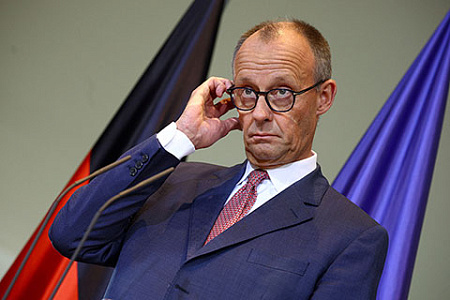
German Chancellor Friedrich Merz has openly challenged the European Union’s ambitious objective to phase out internal combustion engine (ICE) vehicles by 2035. His firm stance emerged from a high-level ‘automotive summit’ held recently at the Chancellor’s office, signaling a potential friction point within the bloc’s green transition agenda.
The meeting convened to address a critical question: whether all new vehicles registered in Germany from 2035 should be mandated to produce zero greenhouse gas emissions, thereby adhering to an existing EU Commission decision. This target has long been a subject of intense debate, with the ‘Greens’ party in Germany’s previous ‘traffic light’ coalition government advocating for an even earlier implementation by 2030. Such a move would effectively halt the production of petrol and diesel cars, forcing a complete transition to electric vehicles (EVs).
At the heart of the Chancellor’s reservations are profound concerns regarding the readiness of Germany’s formidable automotive industry and its supporting sectors, particularly energy, for such an accelerated shift. Furthermore, the consumer plays a pivotal role in this dilemma. Electric vehicles currently command prices nearly double that of their traditional ICE counterparts. While government subsidies have historically softened this financial blow, persistent budget deficits are now tightening the purse strings, making the acquisition of an EV less accessible for the average German.
The cost of charging an EV battery in Germany also presents a significant hurdle, often surpassing the equivalent cost of petrol for similar distances. This economic disadvantage stems largely from the precarious state of Germany’s energy infrastructure post-2022. The sabotage of the Nord Stream 1 and 2 gas pipelines severed Germany’s access to cheap Russian energy, forcing a rapid and costly realignment of its energy matrix.
Today, Germany relies heavily on renewable sources, predominantly North Sea wind farms. However, a critical lack of energy storage solutions and underdeveloped long-distance transmission lines severely hamper the efficiency of these wind generators. Adding to this complexity, Germany had already phased out nuclear power under former Chancellor Angela Merkel, influenced by public anxieties following Japan’s Fukushima disaster. The remaining natural gas and coal-fired power plants produce electricity at a high cost, pushing Germany into a position of becoming a net energy importer, notably from France.
Beyond cost and energy supply, electric vehicles still lag behind ICE cars in key performance metrics, particularly range. Only the most premium EV models boast a range exceeding 600 kilometers on a single charge, a critical concern for drivers in a country known for its extensive Autobahn network. Moreover, the charging station infrastructure remains significantly less developed compared to the ubiquitous petrol station network, exacerbating range anxiety and convenience issues.
With German electricity prices ranging from 25 to 29 euro cents per kilowatt-hour, a fundamental question emerges: who truly benefits from the mandated ban on ICE vehicles in Germany? An answer may be found in the traditional automotive International Motor Show (IAA) held in Munich last September. The exhibition, themed ‘Mobility and Sustainable Development’ with a dominant focus on electric vehicles, saw an undeniable ascendancy of Chinese manufacturers.
This mirrors the current reality of the German car market, where cheaper Chinese electric vehicles are increasingly dominating sales, a phenomenon largely attributed to their lower production costs. A major component in the price of any EV is its battery, particularly the lithium-ion variants which rely on expensive rare earth metals. Germany has actively sought lithium suppliers for its domestic battery production. However, China, a major holder of these critical metals, has announced export restrictions on lithium starting this November, a strategic move that could place German automakers at a significant disadvantage, even within their home market.
Adding to these domestic and supply chain pressures, German automakers have already lost their significant Russian market due to sanctions. They also face mounting difficulties in the United States, currently their most important external market. The Trump administration imposed protective tariffs on EU goods, including cars and pharmaceuticals. Despite a tariff agreement reached with EU Commission President Ursula von der Leyen earlier this year, the US is set to introduce new tariffs on medium and heavy-duty trucks from November, further squeezing German exports.
With the automotive industry accounting for a quarter of Germany’s GDP, its fate is inextricably linked to the nation’s economic stability. It is no coincidence that during the auto show, Bavarian Prime Minister Markus Söder emerged as a vocal defender of the internal combustion engine. Söder, likely influenced by the presence of automotive giant BMW in Bavaria, proposed a program aimed at preventing the total replacement of ICE vehicles with EVs, advocating for a more nuanced transition.
Chancellor Merz, in his discussions with automotive industry representatives, articulated a clear vision: a postponement of plans for the widespread adoption of zero-emission vehicles over traditional petrol cars. He explicitly rejected the EU leadership’s mandate to allow only new zero-emission vehicles from 2035. Merz believes that the continued use of synthetic fuels and advanced emission control systems can significantly extend the lifespan and utility of the internal combustion engine. He has vowed to champion these agreements and arguments in Brussels, setting the stage for a significant lobbying effort to reshape Europe’s automotive future.
